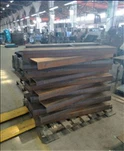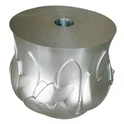Hey there! As a supplier in the metal laser cutting business, I've seen firsthand how crucial the assist gas flow rate is in the whole process. Let's dig into how this little - known factor can have a huge impact on metal laser cutting.
The Basics of Metal Laser Cutting and Assist Gas
First off, for those who aren't super familiar with metal laser cutting, it's a process where a high - powered laser beam is used to melt, burn, or vaporize metal. And assist gas plays a key role here. The assist gas is usually blown through a nozzle along with the laser beam. It helps to remove the molten metal from the cutting area, cools the cutting zone, and can even prevent oxidation in some cases.
There are different types of assist gases used in metal laser cutting, like oxygen, nitrogen, and argon. Oxygen is often used for cutting mild steel because it reacts with the metal, releasing additional energy and speeding up the cutting process. Nitrogen, on the other hand, is great for stainless steel and aluminum. It creates a clean cut with minimal oxidation. And argon is typically used for very thin metals or when a high - quality, oxide - free cut is needed.
How Assist Gas Flow Rate Affects the Cutting Process
Cut Quality
One of the most noticeable effects of the assist gas flow rate is on the cut quality. If the flow rate is too low, the molten metal won't be removed effectively from the cutting area. This can lead to dross (unwanted molten metal residue) sticking to the bottom of the cut. Dross not only makes the cut look messy but can also affect the functionality of the part. For example, if you're cutting parts for a machine, dross can interfere with the proper fit and operation of the components.
On the flip side, if the flow rate is too high, it can cause turbulence in the cutting zone. This turbulence can disrupt the laser beam and lead to an uneven cut. The edges of the cut may become rough, and the overall precision of the cut can be compromised. So, finding the right balance is crucial for achieving a high - quality cut.
We offer High Precision 5mm Carbon Steel Cut Custom Laser Cut Steel, and getting the assist gas flow rate right is essential to ensure the precision and quality that our customers expect.
Cutting Speed
The assist gas flow rate also has a direct impact on the cutting speed. A higher flow rate can generally increase the cutting speed because it helps to remove the molten metal more quickly. This allows the laser to move through the metal faster. However, as I mentioned earlier, there's a limit to how high the flow rate can go. If it's too high, the negative effects on cut quality will start to outweigh the benefits of increased speed.
For different types of metals and thicknesses, the optimal flow rate for maximum cutting speed varies. For example, when cutting thick steel, a relatively higher flow rate might be needed to keep up with the large amount of molten metal being produced. But for thin aluminum sheets, a lower flow rate can be sufficient to achieve a good balance between speed and quality.
Heat Affected Zone (HAZ)
The heat affected zone is the area around the cut where the metal's properties have been altered due to the heat from the laser. A proper assist gas flow rate can help to minimize the HAZ. When the assist gas cools the cutting zone, it reduces the amount of heat that spreads into the surrounding metal.
If the flow rate is too low, the heat will linger in the cutting area, causing a larger HAZ. This can lead to changes in the metal's hardness, strength, and other mechanical properties. In some applications, a large HAZ can be a major problem. For instance, in the aerospace industry, where precision and material properties are critical, minimizing the HAZ is of utmost importance.
Factors Influencing the Optimal Assist Gas Flow Rate
Metal Type and Thickness
As I've briefly mentioned, different metals and thicknesses require different assist gas flow rates. Thicker metals generally need a higher flow rate to remove the larger volume of molten metal. For example, cutting a 10mm thick steel plate will require a much higher flow rate than cutting a 1mm thick aluminum sheet.


Also, different metals have different melting points and chemical properties. For example, stainless steel has a higher melting point than mild steel, so it may need a different assist gas and flow rate combination to achieve a clean cut.
Laser Power
The power of the laser also plays a role in determining the optimal assist gas flow rate. A higher - powered laser will generate more heat and melt more metal in a shorter period. This means that a higher flow rate of assist gas is usually needed to keep up with the increased amount of molten metal.
However, it's not a simple linear relationship. Sometimes, even with a high - powered laser, a very high flow rate may not be necessary if the metal is thin or has a low melting point.
Finding the Right Assist Gas Flow Rate
Finding the optimal assist gas flow rate is a bit of a trial - and - error process. We usually start with some general guidelines based on the metal type, thickness, and laser power. Then, we make small adjustments and test the cuts.
We use advanced sensors and monitoring systems to measure the cut quality, cutting speed, and other parameters. These systems help us to fine - tune the assist gas flow rate in real - time. And of course, our experienced technicians play a crucial role in this process. They can spot any issues with the cut and make the necessary adjustments quickly.
We also offer Custom Logo Laser Cut Metal Good Quality and Custom High Precision Stainless Steel or Carbon Steel Cutting Laser. For these custom jobs, getting the assist gas flow rate right is even more important because the precision and quality requirements are often very high.
Conclusion
In conclusion, the assist gas flow rate is a critical factor in metal laser cutting. It affects the cut quality, cutting speed, and the heat affected zone. By understanding how different factors influence the optimal flow rate and using the right techniques to find it, we can achieve high - quality cuts for our customers.
If you're in the market for metal laser cutting services, whether it's for custom parts, logos, or high - precision components, we're here to help. We've got the experience and the technology to ensure that every cut is perfect. Reach out to us to start a conversation about your project and let's work together to get the best results.
References
- "Laser Cutting: Theory and Practice" by John Doe
- "Advances in Metal Cutting Technologies" by Jane Smith






